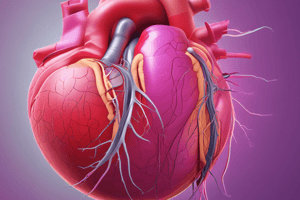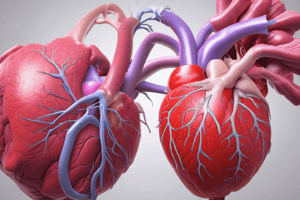Podcast
Questions and Answers
What is the approximate incidence of pericarditis following a myocardial infarction (MI)?
What is the approximate incidence of pericarditis following a myocardial infarction (MI)?
- 5% to 10%
- 25% to 30%
- 35% to 40%
- 15% to 20% (correct)
What percentage of individuals with pericarditis experience a recurrence?
What percentage of individuals with pericarditis experience a recurrence?
- 20% to 30% (correct)
- 30% to 40%
- 15% to 20%
- 10% to 15%
Which of the following is NOT a typical cause of pericarditis?
Which of the following is NOT a typical cause of pericarditis?
- Autoimmune disorders
- Metabolic imbalances
- Infectious agents
- Hypovolemia (correct)
Which of the following findings is MOST indicative of cardiac tamponade?
Which of the following findings is MOST indicative of cardiac tamponade?
A patient reports chest pain that is relieved when leaning forward. Which condition is most likely?
A patient reports chest pain that is relieved when leaning forward. Which condition is most likely?
What percentage of pericarditis patients might exhibit a pericardial friction rub upon auscultation?
What percentage of pericarditis patients might exhibit a pericardial friction rub upon auscultation?
Which of the following ECG changes are typically associated with pericarditis?
Which of the following ECG changes are typically associated with pericarditis?
Besides chest pain, what other symptom is common in patients with pericarditis?
Besides chest pain, what other symptom is common in patients with pericarditis?
Which of the following ECG changes is a hallmark finding in pericarditis?
Which of the following ECG changes is a hallmark finding in pericarditis?
A chest x-ray of a patient with pericarditis may show which of the following?
A chest x-ray of a patient with pericarditis may show which of the following?
Which of the following laboratory tests is NOT typically used in the diagnosis of pericarditis?
Which of the following laboratory tests is NOT typically used in the diagnosis of pericarditis?
Which position is most beneficial for a client with pericarditis experiencing pain and shortness of breath?
Which position is most beneficial for a client with pericarditis experiencing pain and shortness of breath?
Which class of medication is primarily used to manage the inflammation associated with pericarditis?
Which class of medication is primarily used to manage the inflammation associated with pericarditis?
What is a critical complication of pericarditis that nurses should monitor for?
What is a critical complication of pericarditis that nurses should monitor for?
Which of the following symptoms, when observed in a client with pericarditis, would suggest the development of cardiac tamponade?
Which of the following symptoms, when observed in a client with pericarditis, would suggest the development of cardiac tamponade?
What finding on an echocardiogram would indicate a potential complication of pericarditis?
What finding on an echocardiogram would indicate a potential complication of pericarditis?
What is a primary benefit of valvuloplasty over valve replacement?
What is a primary benefit of valvuloplasty over valve replacement?
Which type of valve replacement typically requires lifelong anticoagulation therapy?
Which type of valve replacement typically requires lifelong anticoagulation therapy?
A patient with a mechanical valve replacement should be educated to do which of the following, regarding food intake?
A patient with a mechanical valve replacement should be educated to do which of the following, regarding food intake?
What action is important for patients with valve replacements to take prior to procedures?
What action is important for patients with valve replacements to take prior to procedures?
What is the most common cause of pericarditis according to the text?
What is the most common cause of pericarditis according to the text?
What is the primary focus of treatment for patients diagnosed with pericarditis?
What is the primary focus of treatment for patients diagnosed with pericarditis?
A patient with a known valve replacement is scheduled for a routine dental cleaning. What prophylactic measure might be considered?
A patient with a known valve replacement is scheduled for a routine dental cleaning. What prophylactic measure might be considered?
If a patient taking warfarin expresses concern about their anticoagulant therapy and bleeding risk, which safety suggestion should NOT be considered?
If a patient taking warfarin expresses concern about their anticoagulant therapy and bleeding risk, which safety suggestion should NOT be considered?
Flashcards
What is acute pericarditis?
What is acute pericarditis?
A condition where the sac surrounding the heart (pericardium) becomes inflamed. It can occur after a heart attack (MI), be caused by infections, or have other causes.
Who is more prone to acute pericarditis?
Who is more prone to acute pericarditis?
Acute pericarditis is more common in men and young to middle-aged people.
What can an excessive buildup of pericardial fluid lead to?
What can an excessive buildup of pericardial fluid lead to?
A significant increase in pericardial effusion can lead to a life-threatening condition called cardiac tamponade, which restricts the heart's ability to pump effectively.
What is a common auscultatory finding in pericarditis?
What is a common auscultatory finding in pericarditis?
Signup and view all the flashcards
How can pericarditis pain be distinguished from heart attack pain?
How can pericarditis pain be distinguished from heart attack pain?
Signup and view all the flashcards
What significant ECG changes can be seen in pericarditis?
What significant ECG changes can be seen in pericarditis?
Signup and view all the flashcards
Why is the true prevalence of pericarditis difficult to determine?
Why is the true prevalence of pericarditis difficult to determine?
Signup and view all the flashcards
How can pericarditis be categorized?
How can pericarditis be categorized?
Signup and view all the flashcards
What is pericarditis?
What is pericarditis?
Signup and view all the flashcards
What ECG abnormalities are seen in pericarditis?
What ECG abnormalities are seen in pericarditis?
Signup and view all the flashcards
What might a chest X-ray reveal in a patient with pericarditis?
What might a chest X-ray reveal in a patient with pericarditis?
Signup and view all the flashcards
How does an echocardiogram help diagnose pericarditis?
How does an echocardiogram help diagnose pericarditis?
Signup and view all the flashcards
What is cardiac tamponade?
What is cardiac tamponade?
Signup and view all the flashcards
What are the signs of cardiac tamponade?
What are the signs of cardiac tamponade?
Signup and view all the flashcards
What medications are used to treat pericarditis?
What medications are used to treat pericarditis?
Signup and view all the flashcards
How does positioning the patient help in pericarditis?
How does positioning the patient help in pericarditis?
Signup and view all the flashcards
Valvuloplasty
Valvuloplasty
Signup and view all the flashcards
Commissurotomy
Commissurotomy
Signup and view all the flashcards
Balloon valvuloplasty
Balloon valvuloplasty
Signup and view all the flashcards
Annuloplasty
Annuloplasty
Signup and view all the flashcards
Leaflet repair
Leaflet repair
Signup and view all the flashcards
Chordoplasty
Chordoplasty
Signup and view all the flashcards
Valve Replacement
Valve Replacement
Signup and view all the flashcards
Mechanical valve
Mechanical valve
Signup and view all the flashcards
Study Notes
Tracheostomy
- Maintain patent airway
- Monitor respiratory status
- High fowler's position
- Mechanical ventilation support of tracheostomy collar if indicated
- Maintain surgical drains in neck if present
- Observe for hemorrhage and edema in the neck
- Monitor vital signs (decreased BP with blood loss, increased HR due to hypovolemia and pain)
- Monitor oxygenation status (edema and increased secretions may cause shortness of breath and decreased oxygen)
- Monitor tracheostomy patency (bleeding/edema may occur impairing patency)
- Monitor nutritional intake (swallowing impairments impact adequate nutrition)
- Institute aspiration precautions (at risk for aspiration due to removal of upper airway structures)
- Provide means of communication
- Consult with nutritional specialist and speech/language pathologist
- Monitor IV fluids or parental nutrition until enteral nutrition can be administered.
Mechanical Ventilation
- Provides ventilation when the patient cannot breathe on their own
- Provides airway access via orotracheal intubation or tracheostomy tube
Nursing Interventions
- Protect airway
- Monitor vital signs, lung sounds, respiratory status, and breathing pattern
- Monitor chest for bilateral expansion
- Obtain pulse oximetry and blood gas analysis (ABGs)
- Assess the need for suctioning
- Investigate ventilator alarms and manually ventilate client with resuscitation bag if necessary.
- Provide humidification
Suctioning
- Hyperoxygenate before suctioning
- Suction for 10-15 seconds (3 times total)
- Allow 60 seconds of rest and oxygen between each pass
- Perform when adventitious breath sounds are detected
- Perform when secretions are present
- Ensure all equipment is sterile
Ostomy Care
- Colostomy is a surgical opening on the abdomen for fecal elimination
- Ileostomy is a similar procedure when the entire colon is removed.
- Assess the stoma color and integrity frequently (reddish pink and moist)
- Address any unusual bleeding, skin irritation, and stoma ischemia
- Empty the appliance when it's one-third to one-half full
- Monitor the stool consistency (liquid to formed based on ostomy location)
Chest Tube
- Monitor the amount and color of drainage. (Excessive bloody drainage concerns bleeding within the chest; cloudy drainage may suggest infection)
- Observe the water-seal chamber. (Persistent bubbling indicates an air leak in the chest tube system)
- Maintain a closed chest tube system to prevent air leaks.
- Never clamp the chest tube
- Assess the patient's position for optimal oxygenation (e.g., semi-Fowler's)
Infective Endocarditis (IE)
- IE is an inflammation of the inner lining of the heart and its valves
- Risk factors: Immunosuppression, IV drug abuse, prosthetic valve placement, surgical/invasive procedures.
- Signs and symptoms include fever, anorexia, fatigue, weight loss, Osler nodes, Janeway lesions, and/or splinter hemorrhages.
- Management involves IV antibiotic therapy for a prolonged period and possibly, surgical interventions.
Angina
- Chest pain resulting from an imbalance between oxygen supply and demand in the heart muscles.
- Types: Stable (predictable) and unstable (unpredictable) angina
- Treatment goals are to provide relief and prevent complications like a heart attack.
Pericarditis
- Inflammation of the pericardium (the sac surrounding the heart).
- Common symptoms include chest pain, fever, and/or shortness of breath
Pulmonary Edema
- Buildup of fluid in the lungs.
- Common symptoms include shortness of breath, cough, and/or chest pain
- May present with high ventilation/low perfusion mismatch
- Requires immediate treatment to improve oxygenation.
Laryngeal Cancer
- Malignant tumor of the larynx.
- Risk factors include smoking, alcohol use, and certain occupational exposure(e.g., to radiation)
- Signs/Symptoms: hoarseness, persistent sore throat, change in voice, trouble swallowing, and/or difficulty breathing
Cardiac Biomarkers
- Troponin: a protein that increases in serum when the heart muscles are damaged. It's useful in diagnosing heart attacks.
- CK-MB: Isoenzyme of creatine kinase, primarily found in cardiac muscle tissue. Elevated CK-MB suggests muscle damage
Pulmonary Embolism (PE)
- Occurs when a blood clot (thrombus) travels to the lungs and blocks a pulmonary artery..
- Common risks: Previous blood clots, extended immobility, cancer, surgical procedures.
- Symptoms: shortness of breath, chest pain, and/or coughing up blood (hemoptysis).
Chest Trauma
- Blunt trauma: injury from impact or compression
- Penetrating trauma: injury by an object penetrating the chest
- Assess for respiratory distress and/or cardiovascular compromise.
- Initial interventions: Ensure an airway, give high-flow supplemental oxygen, and consider chest tubes if needed.
Studying That Suits You
Use AI to generate personalized quizzes and flashcards to suit your learning preferences.
Related Documents
Description
Test your knowledge on pericarditis related to myocardial infarction. This quiz covers incidence rates, symptoms, diagnostic findings, and ECG changes associated with pericarditis. Enhance your understanding of this common cardiac condition.



